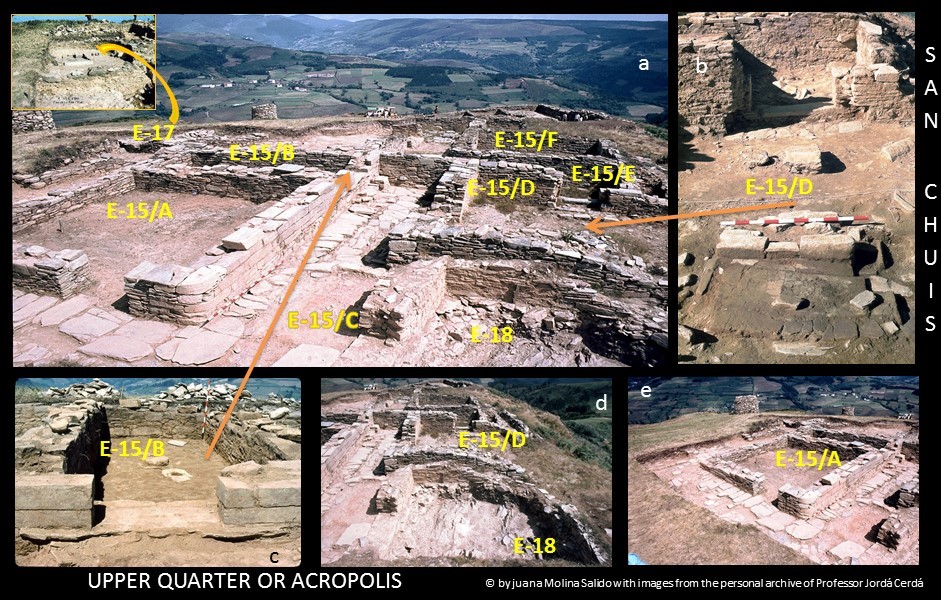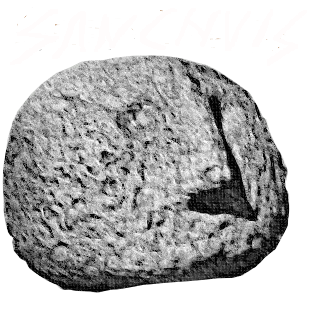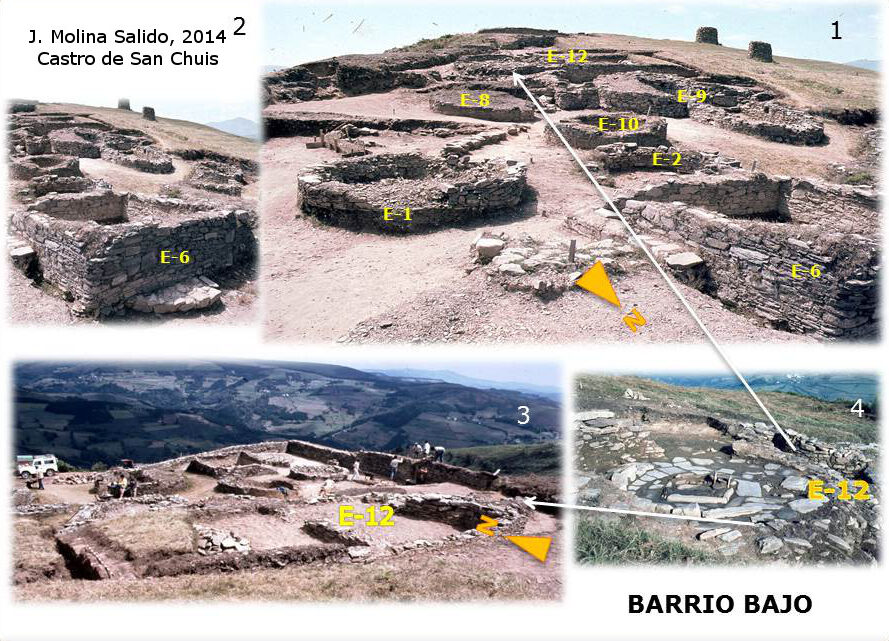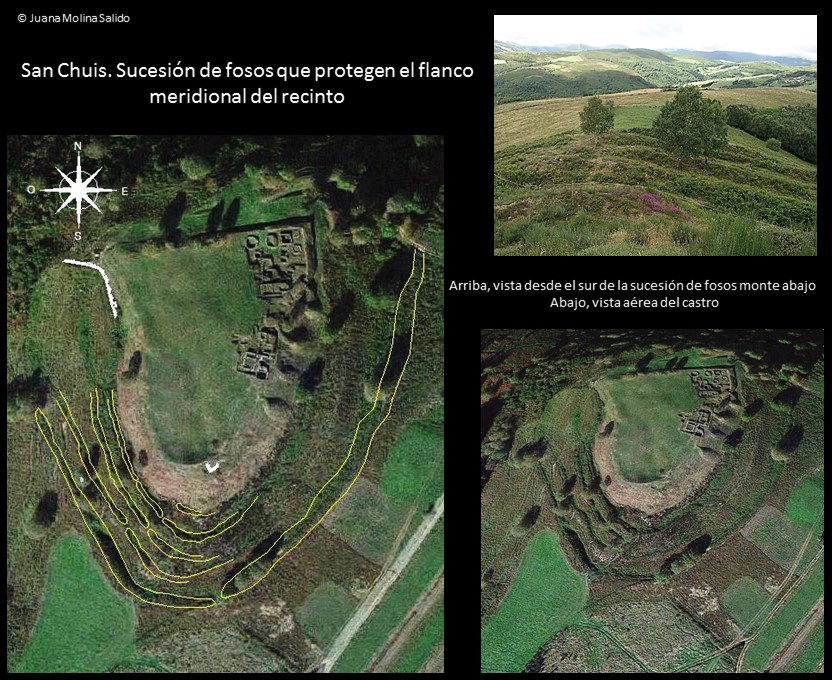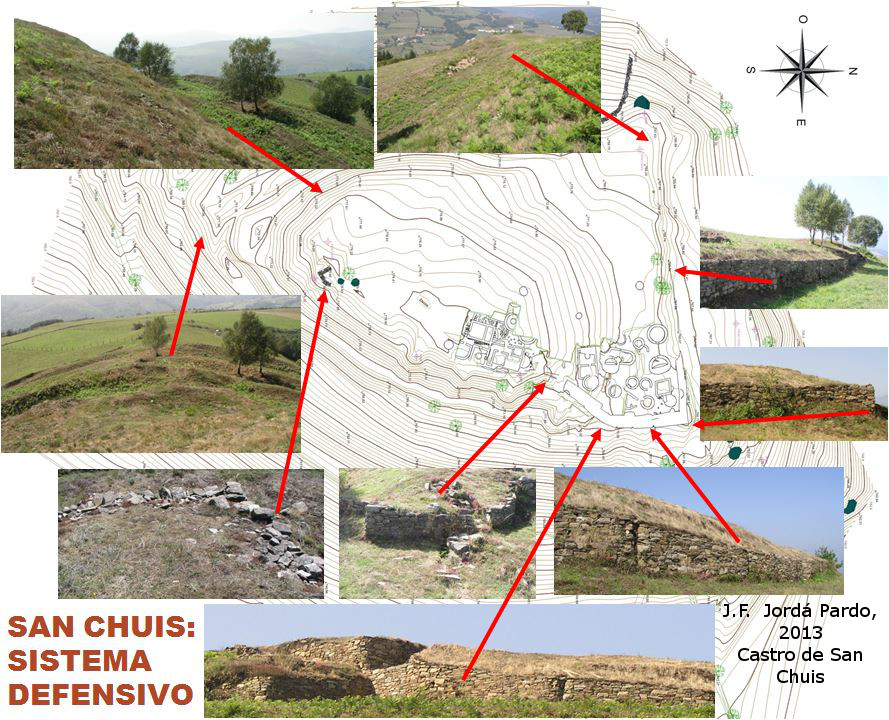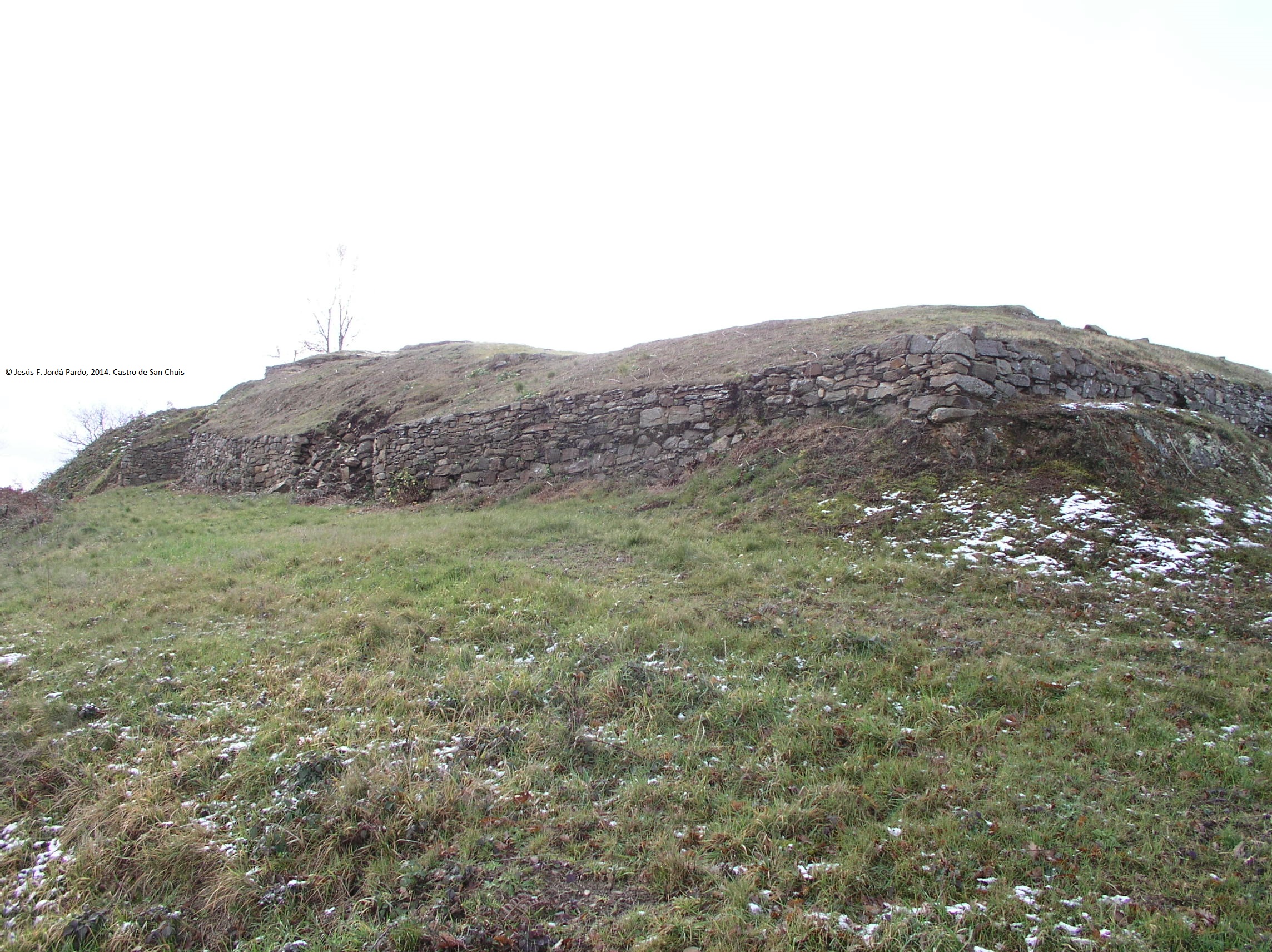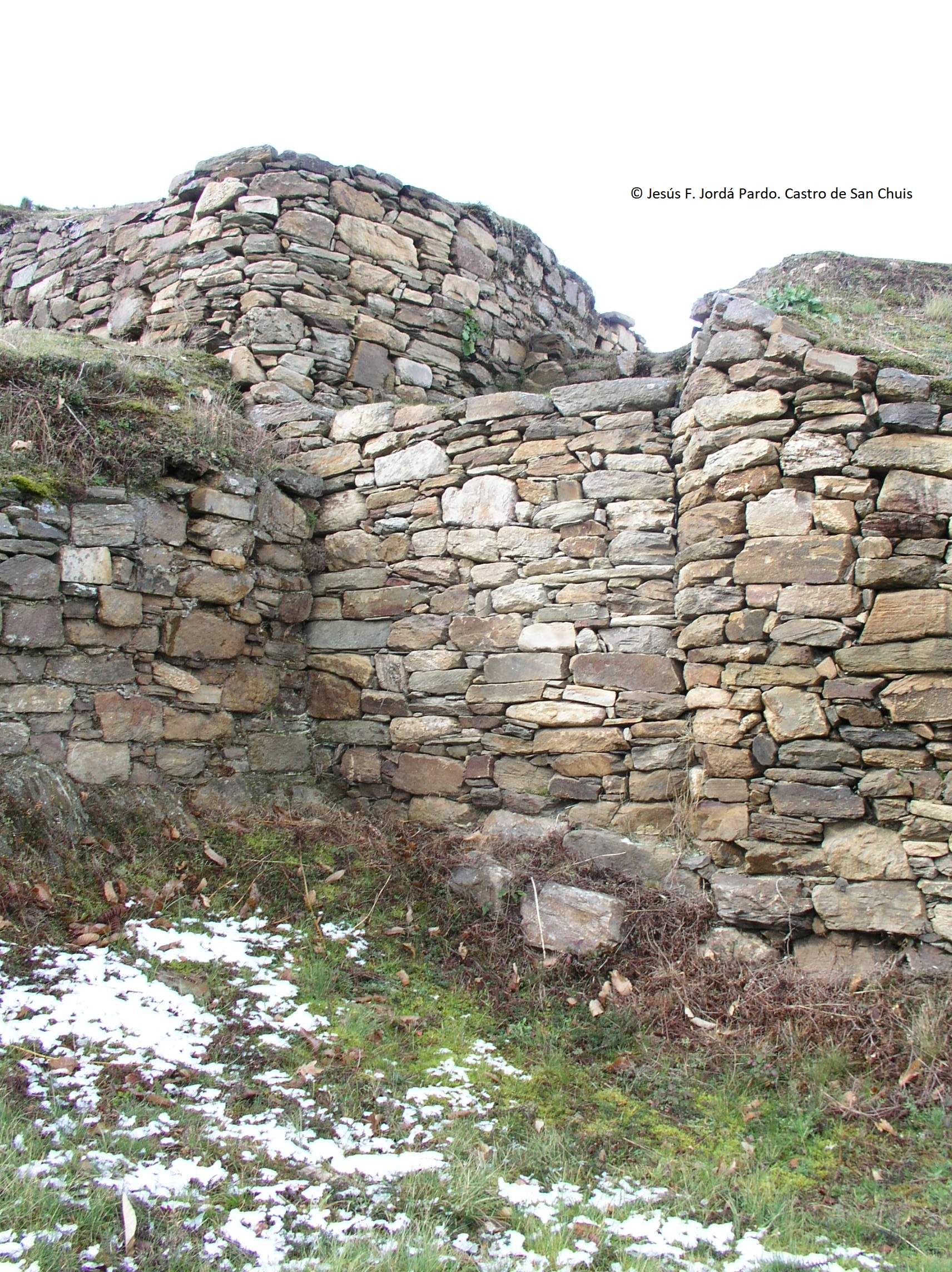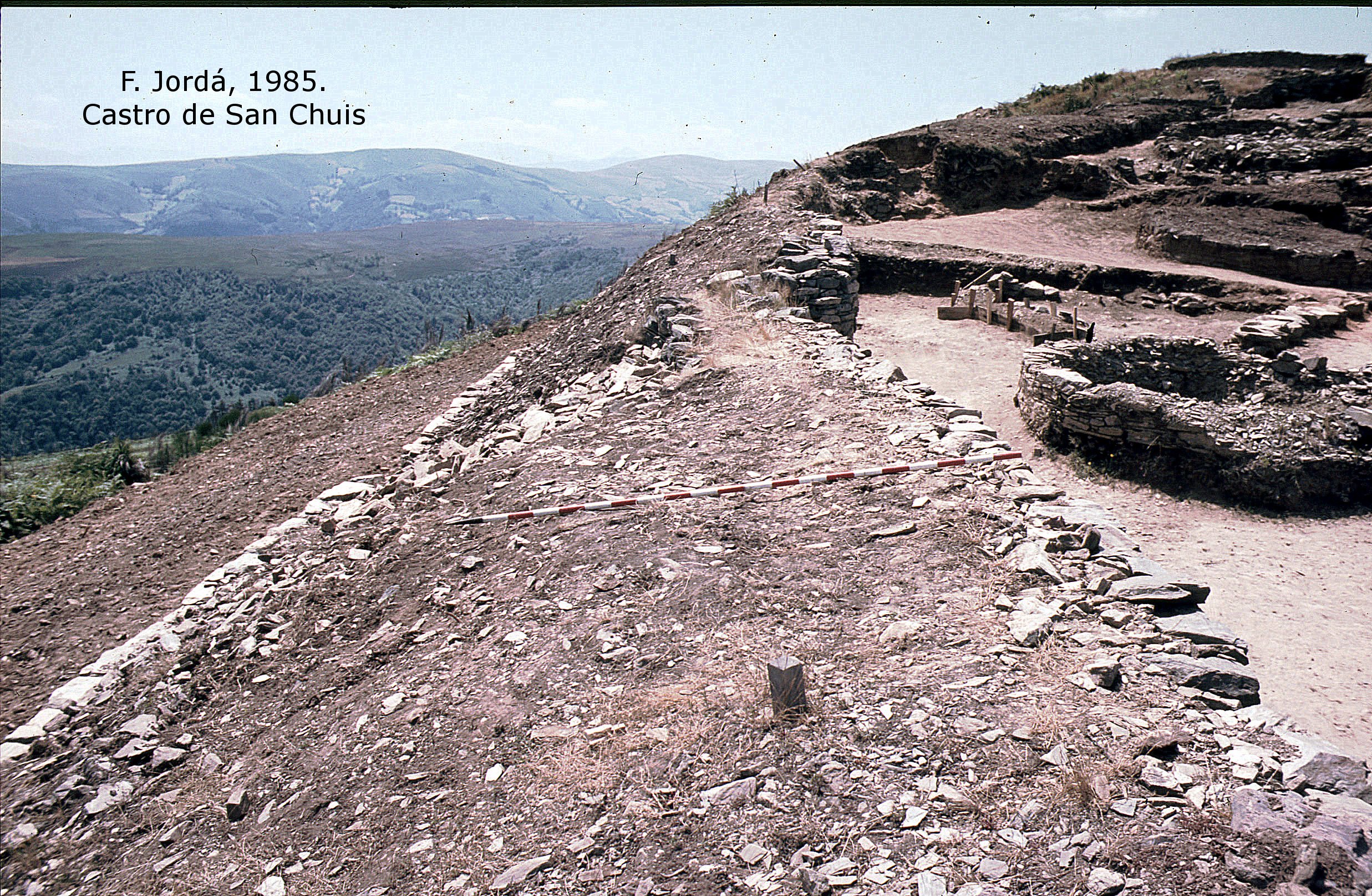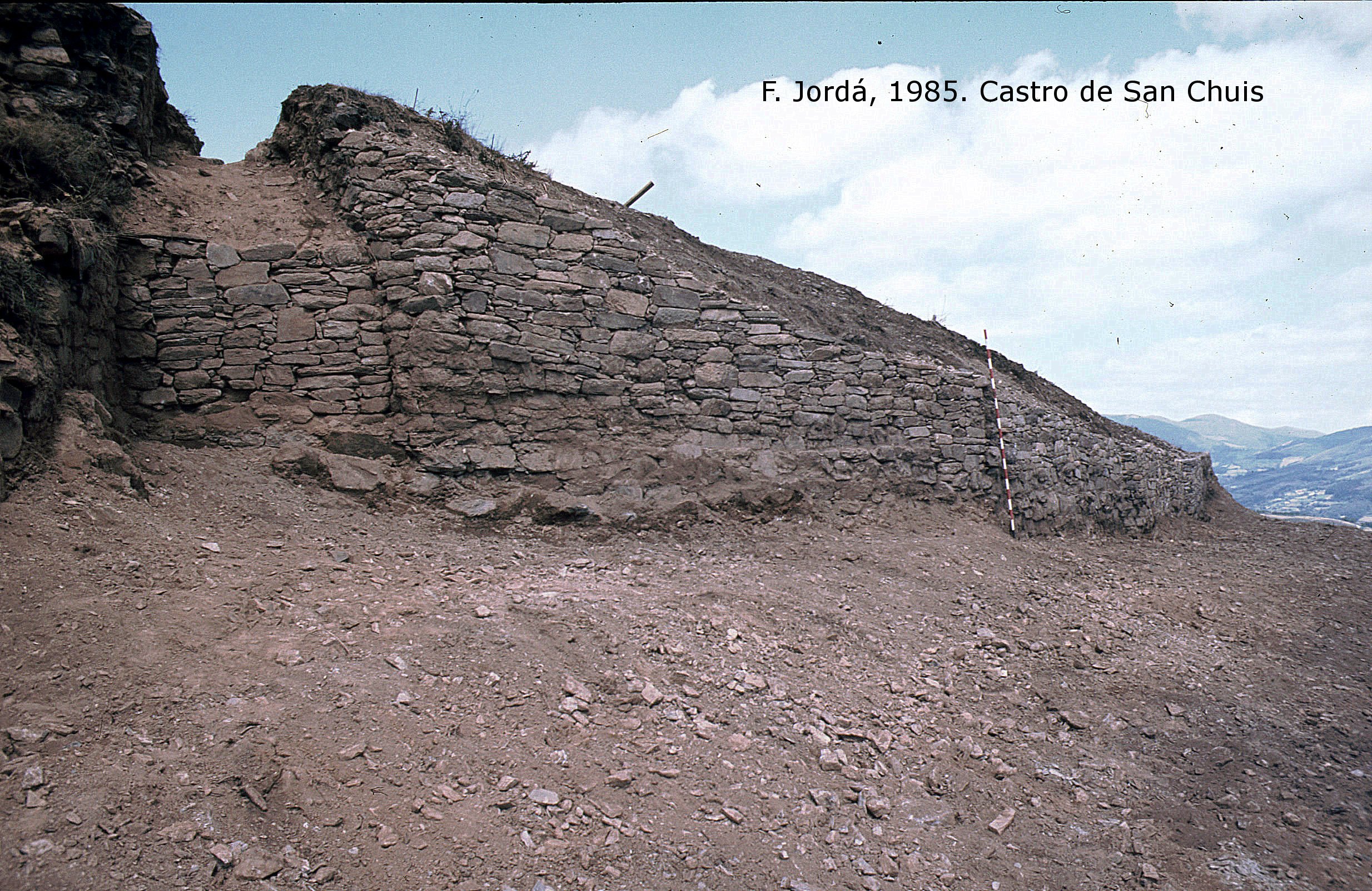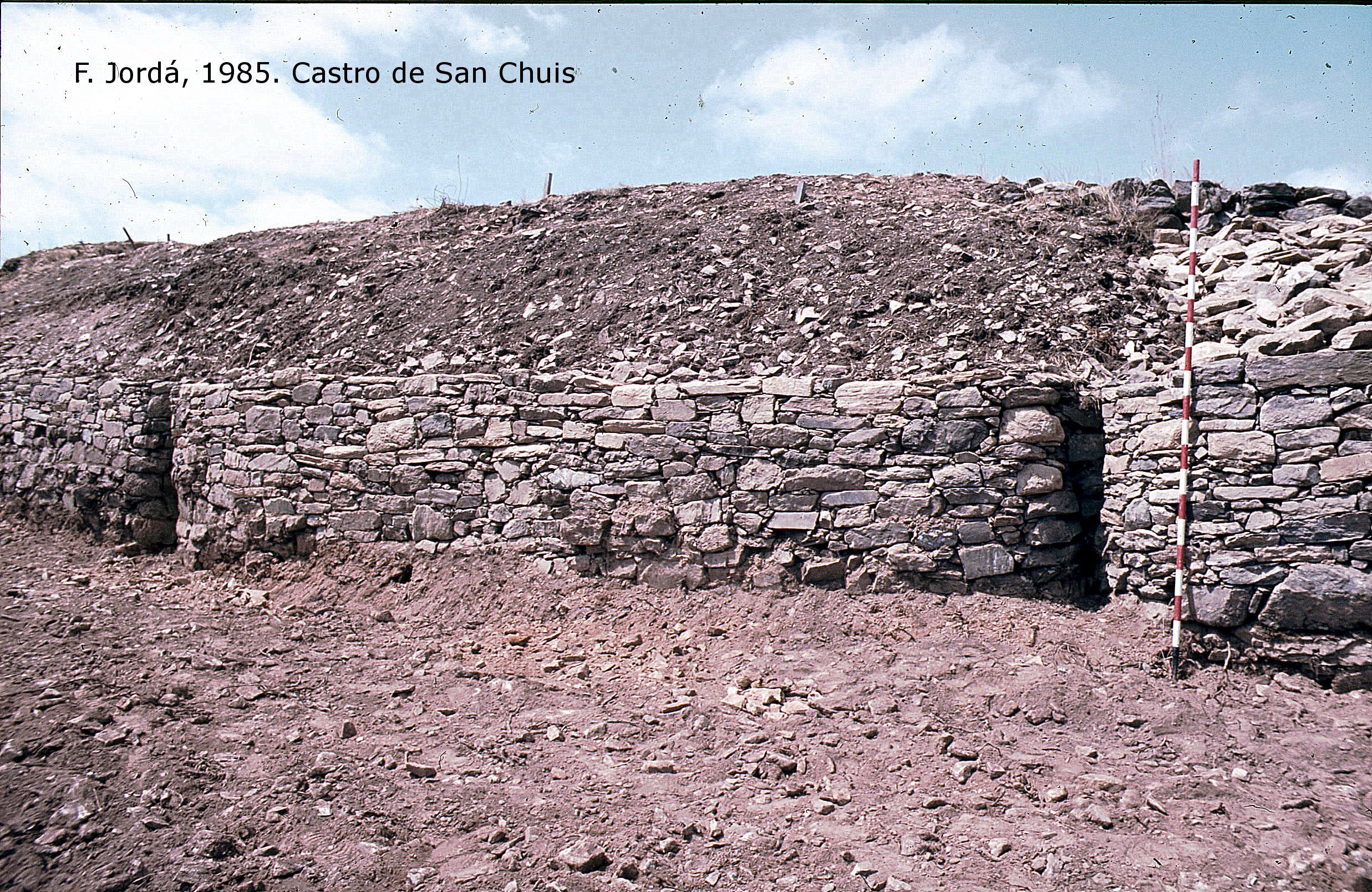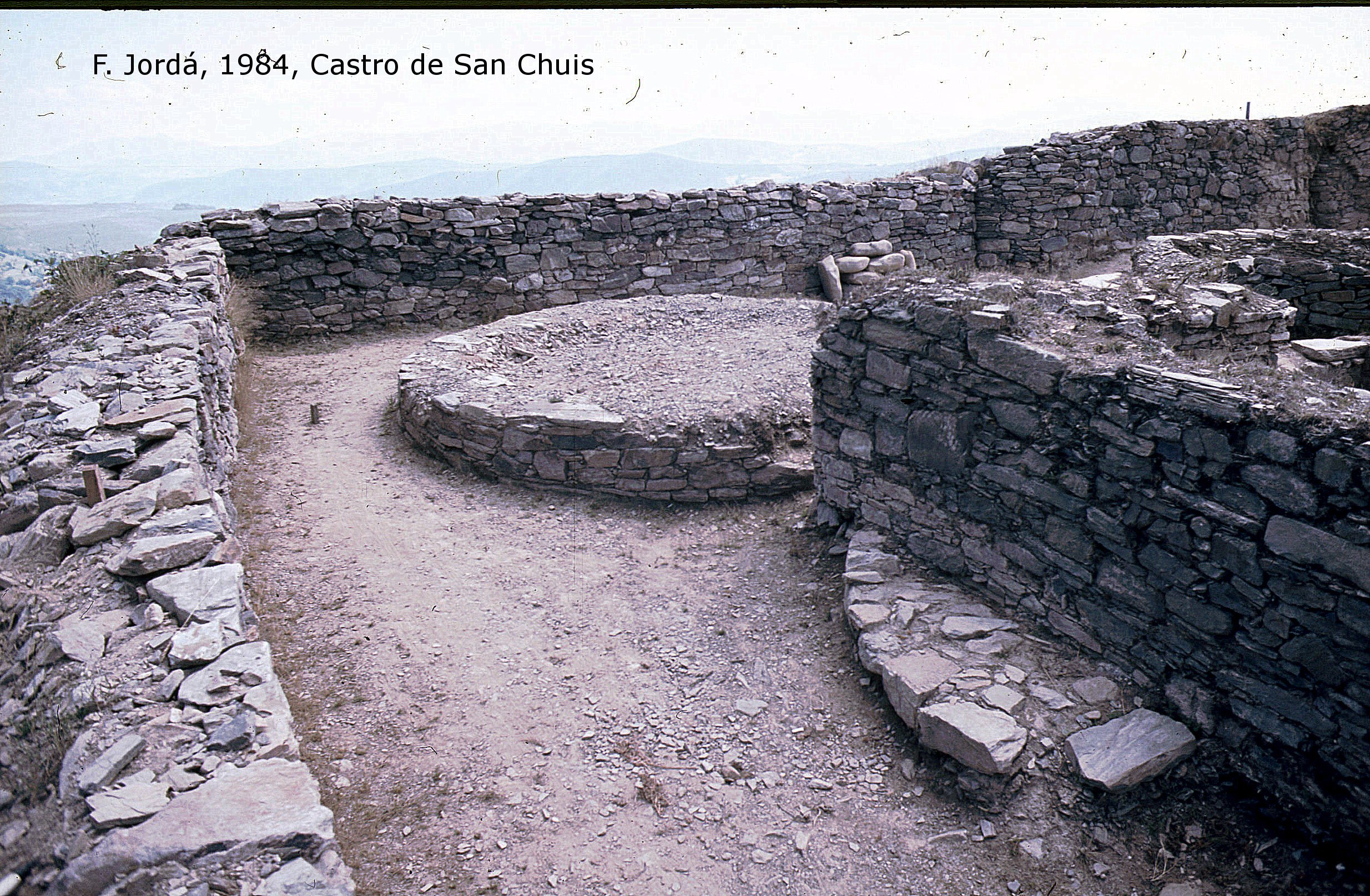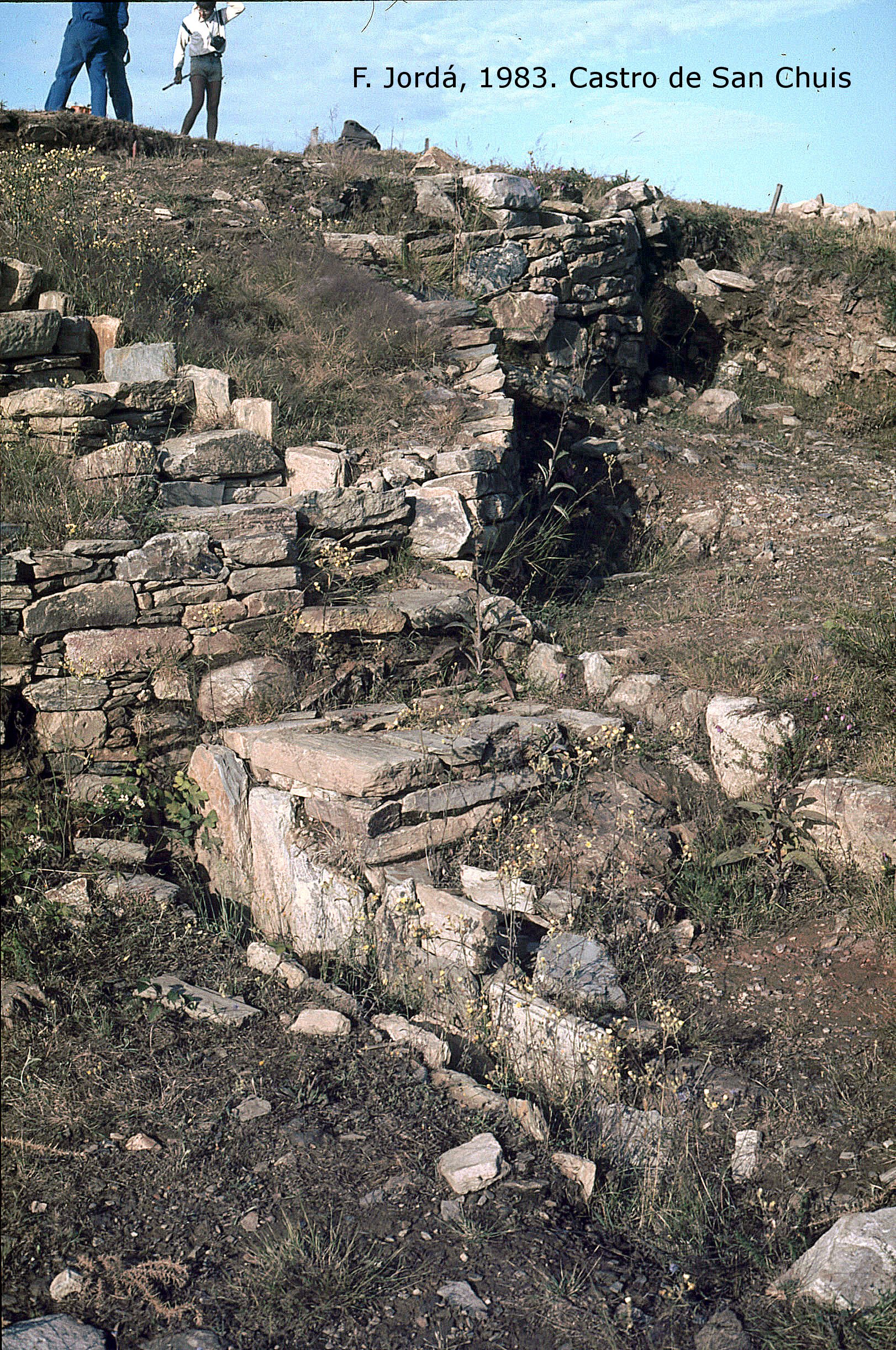En cuanto al urbanismo, en el castro de San Chuis existen dos zonas bien diferenciadas en función principalmente de sus estructuras arquitectónicas: son los llamados barrio bajo y barrio alto o acrópolis. El barrio bajo, situado en el ángulo nordeste está caracterizado por el predominio de las estructuras circulares, con muros de aparejo irregular de pizarra trabada con barro. En el barrio alto, situado en la cumbre, el predominio lo ejercen las estructuras rectangulares, construidas sobre todo a base de sillarejo de pizarra, aunque algunas son de arenisca y porfiroide. Estas estructuras conforman un complejo urbanístico con una orientación de muros y calles en dirección N-S y E-W. En ambas zonas se da una clara superposición de los paramentos rectilíneos, traducidos en estructuras cuadradas o rectangulares, sobre los curvilíneos, lo cual es determinante a la hora de determinar los diferentes momentos cronológicos del registro arqueológico del castro. En cuanto a los sistemas de cubrición, las únicas evidencias localizadas hasta el momento son agujeros de poste próximos a las esquinas interiores de una estructura rectangular del barrio alto, así como un gran número de gruesas lajas de pizarra perforadas en un extremo localizadas en paralelo al exterior de los muros, que probablemente sirvieron de contrapeso en techumbres vegetales.
En el barrio alto resalta una macro-estructura, Estructura 15, varias veces remodelada. Está constituida por un mínimo de 8 subestructuras menores rectangulares, habitaciones, que pueden formar una casa alrededor de un patio. Destacan por su espectacularidad las dos habitaciones contiguas (en imagen) con fachada de sillares de arenisca y porfiroide perfectamente escuadrados y labrados, cuyas esquinas de la fachada principal presentan forma circular. Existen también 4 estructuras circulares, una de ellas arrasada al construir el conjunto de estructuras rectangulares, y dos remodeladas con muros rectilíneos añadidos.
En el barrio bajo se han exhumado 15 estructuras circulares y una sola cuadrangular, superpuesta a dos de las anteriores. Además, aparecen dos remodelaciones de estructuras circulares a las que se les han añadido muros rectilíneos (Estructuras 9 y 12), formando estructuras complejas con varias habitaciones.
Como forma arquitectónica sobresaliente, queremos destacar la ya mencionada Estructura 12, situada en la parte sur del barrio bajo, a media pendiente, constituida por una habitación circular, a la que se le ha añadido por delante de su puerta un anexo rectangular dividido en dos habitaciones. El suelo de la habitación redonda se encuentra totalmente enlosado por grandes lajas de pizarra, con un banco alrededor de un hogar de tégula y pizarra situado en el centro y limitado por bloques alargados de esta roca. Además, aparece una especie de repisa de sillarejo de pizarra adosado al muro y una piedra con cazoleta enterrada a ras del enlosado en el borde norte de la citada habitación.
Regarding the urban planning, in San Chuis hillfort there are two well differentiated areas based mainly on their architectural structures: they are called the Lower Quarter and the Upper Quarter or Acropolis. The lower quarter, located in the northeast corner, is characterized by the predominance of circular structures, with walls of irregular slate stonework bonded with mud. In the Upper Quarter, located at the summit, the predominance is exercised by rectangular structures, built mainly of slate ashlar, although some are sandstone and porphyroid. These structures form an urban complex with an orientation of walls and streets in the North-South and East-West direction. In both zones there is a clear superposition of the rectilinear paraments that translates into square or rectangular structures, over the curvilinear ones, which is clearly decisive in determining the different chronological moments of the archaeological record of the hillfort. As for the cover systems, the only evidence found so far are post holes near the inner corners of a rectangular structure in the Upper Quarter, as well as a large number of thick slate slabs drilled at one end located in parallel to the outside of the walls, which probably served as a counterbalance in plant roofs.
In the Upper Quarter, a macro-structure, Structure 15, several times remodeled, stands out. It consists of a minimum of 8 rectangular minor substructures, rooms, which can form a house around a court. The two adjacent rooms (in image) stand out for their spectacularity, with a façade of sandstone and porphyry stone perfectly squared and carved, whose corners of the main façade have a circular shape. There are also 4 circular structures, one of them destroyed when building the set of rectangular structures, and two remodeled with added rectilinear walls.
In the Lower Quarter, 15 circular structures and a single quadrangular one, superimposed on two of the previous ones, have been exhumed. In addition, two remodels of circular structures to which rectilinear walls have been added appear (Structures 9 and 12), forming complex structures with several rooms.
As an outstanding architectural form, we would like to highlight the aforementioned Structure 12, located in the southern part of the Lower Quarter, at half slope, consisting of a circular room, to which a rectangular annex divided into two rooms has been added in front of its door. The floor of the round room is completely paved by large slabs of slate, with a bench around a fireplace of tegula and slate located in the center and limited by elongated blocks of this rock. In addition, there is a kind of slate ashlar ledge attached to the wall, and a stone with a sort of central cuvette carved placed at the ground level, on the north edge of the aforementioned room.
THE RAMPART AND THE DEFENSIVE SYSTEM
San Chuis, following the settlement pattern of the hillforts, is located on the top of a peak, which already provides it with unbeatable natural defenses. However, and despite this, the village was endowed with a complex defensive system that protected it. Thus, on the North, East and West slopes, which already show a remarkable steepness, a set of three moats is constructed that makes them inaccessible. In addition, in the East, there is a first moat delimiting a terracing (antecastro). On the other hand, the Southern flank, which is the most accessible because it is the attachment point between the peak and the mountain range, is protected by a system of five successive moats associated with parapets, topped by a bastion built with slate (Jordá Pardo 2009: 51-53; Jordá Pardo, Marín Suárez y García-Guinea 2011: 490) .
On top of that, the entire perimeter of the hillfort is surrounded by a rampart of modules formed in its northern part by a wall about 2 m wide, while in its northeast angle it widens reaching about 4 m of thickness. On the east side it is doubled by a front bastion that protects the door area. This is founded on a stepped base and is delimited on the opposite side by another wall of great dimensions, with a threshold with fittings where perhaps a portcullis could be placed.
LA MURALLA Y EL SISTEMA DEFENSIVO
San Chuis, siguiendo el perfil de asentamiento de los castros, está situado en la cima de un pico, lo que ya le proporciona unas defensas naturales inmejorables. Sin embargo, y a pesar de ello, el poblado fue dotado con un complejo sistema defensivo que lo protegía. Así, en las vertientes N, E y O, que ya muestran una fuerte pendiente, se construye un conjunto de tres fosos que las convierten en inaccesibles. Además, en el E existe un primer foso delimitando un antecastro. Por otra parte, el flanco S, que es el de mayor accesibilidad por ser la zona de unión del pico con la sierra, está protegido por un sistema de cinco fosos sucesivos asociados a parapetos, rematado por un bastión construido mediante lajas de pizarra (Figura 2) (Jordá Pardo 2009: 51-53; Jordá Pardo, Marín Suárez y García-Guinea 2011: 490).
A esto se une que todo el perímetro del castro se encuentra rodeado por una
muralla de módulos compuesta hacia el N por un muro de unos 2 m de anchura, mientras que en el ángulo NE se ensancha alcanzando unos 4 m de grosor, duplicándose en el lado E mediante un bastión delantero, que protege la zona de la puerta. Ésta se fundamenta en un basamento escalonado y se delimita por el lado opuesto por otro muro de grandes dimensiones, contando con un umbral a modo de encaje que podría sugerir una plancha levadiza.
REFERENCIAS
REFERENCES
Jordá Pardo, J. F. (2009). Descubriendo el castro de San Chuis (Allande, Asturias): nuevas aportaciones al conocimiento de la cronología radiocarbónica de los castros asturianos. ENTEMU, XVI: 47-63.
Jordá Pardo, J. F., Marín Suárez, C. y García-Guinea, J. (2011). Discovering San Chuis Hillfort (Northern Spain): Archaeometry, Craft Technologies and Social Interpretation. En T. Moore y X. L. Armada (Edits.), Atlantic Europe in the First Millennium BC. Crossing the Divide: 488-505. Oxford: Oxford
University Press.
Molina Salido, J (2018). From the Archaeological Record to Virtual Reconstruction The Application of Information Technologies at an Iron Age Fortified Settlement (San Chuis Hillfort, Allande, Asturias, Spain). Oxford: Archaeopress Publishing Ltd.
